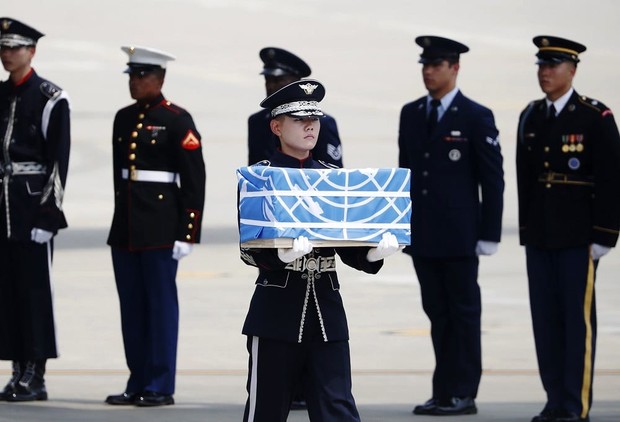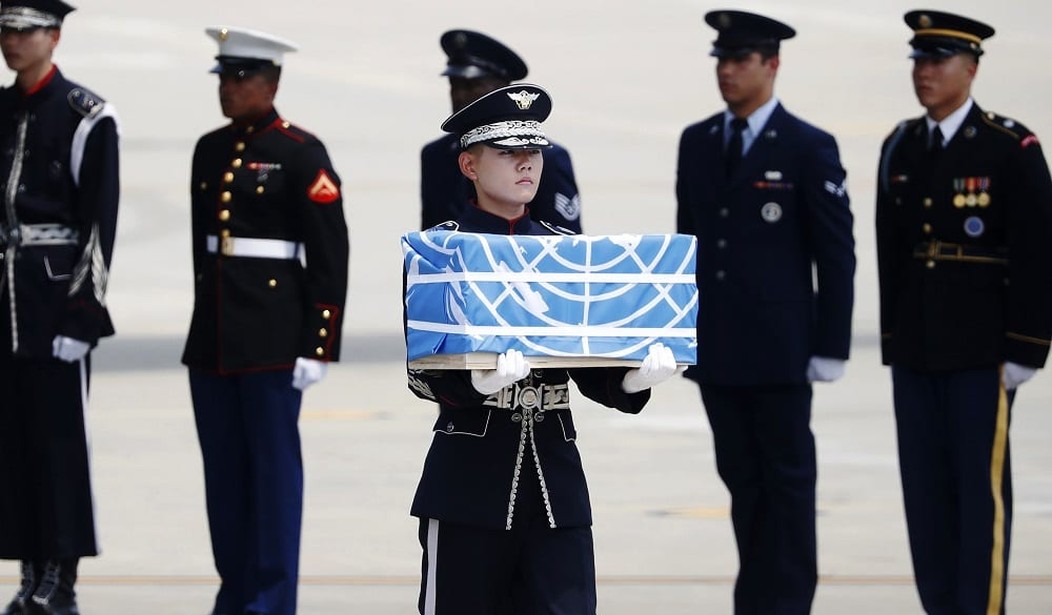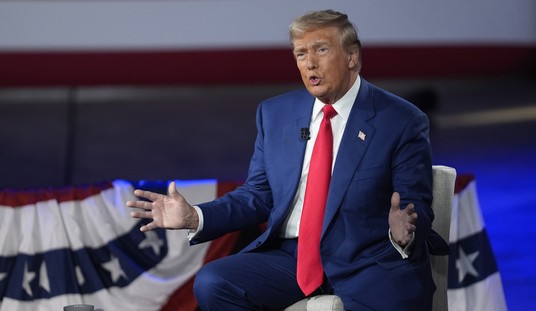
A soldier carries a casket containing a remain of a U.S. soldier who was killed in the Korean War during a ceremony at Osan Air Base in Pyeongtaek, South Korea, Friday, July 27, 2018. The U.N. Command said the 55 cases of war remains retrieved from North Korea will be honored at a ceremony next Wednesday at a base in South Korea. (Kim Hong-Ji/Pool Photo via AP)
A little earlier today, a USAF C-17 landed at Osan AFB, South Korea after departing from Wonsan, North Korea. It carried the remains of some 55 US military personnel who were killed during the Korean War. This is one of the things that North Korean dictator Kim Jong Un agreed to accomplish during the Singapore summit meeting.
UN Command says remains of 55 American service members from the Korean War were returned by North Korea.
A U.S. cargo aircraft flew to North Korea to receive the remains and returned promptly to Osan Air Base in South Korea. https://t.co/x7kczu8yC6 pic.twitter.com/CscjLn1JAA
— ABC News (@ABC) July 27, 2018
Former New Mexico governor Bill Richardson, who has worked on repatriation issues and visited North Korea several times, said Thursday that he saw the potential recovery as a positive first step. But he warned that Pyongyang could stall in delivering other remains and attempt to use the issue as a way to make money.
“They’ll give a certain amount of remains for free right away,” Richardson predicted. “But then they’ll say, ‘The next ones, we need to find them, locate them, restore them.’ And then they’ll start charging, and they’ll milk this.”
Though the United States has a policy of refusing to pay for the repatriation of remains, in the past, it has agreed to provide some funding for expenses incurred by the North Koreans.
The Pentagon estimates that nearly 7,700 U.S. troops are unaccounted for from the war; among them are 5,300 believed to have been killed north of the 38th parallel, which largely coincides with the boundary between North and South Korea.
The North Korean government is believed to have somewhere between 120 and 200 sets of U.S. military remains in its possession and ready to deliver, but there are thousands more still in the North Korean countryside, said Mickey Bergman, vice president of the Richardson Center for Global Engagement that the former governor founded.
Some remains were buried by U.S. troops in cemeteries that were intended to be temporary until China’s entry in the Korean War forced U.S. forces to withdraw farther south. Other remains are at sites where aircraft crashed or in unmarked graves, Bergman said.
“One of the things that is so important is for the American people to understand that this is just the beginning,” he said. “This is going to take years. It’s going to take interviews and sight surveys and teams on the ground. My fear is that we will get these remains and once again say ‘Mission accomplished!’ And it’s not.”
The location of many of the MIA’s is not a mystery, according to the Defense POW/MIA Accounting Agency (DPAA)
POW Camps: The locations of the Apex Camps operated by the North Koreans are believed to hold more than 300 remains, and peninsular Camp 5 on the south bank of the Yalu River, is believed to hold another 550. The main Death Valley Camp, also known as Pukchin-Tarigol, is believed to add 350. Most of the men who died at these sites passed during the winter of 1950-51, before food could be delivered reliably and shelter was haphazard at best. By the next winter, conditions were far better and deaths were far fewer. There were many other POW deaths as well, but these were along the wayside or in smaller villages, of which Valley #1 Camp is an example. The villages of the Suan Camps may contain another 225 war dead from several recurrent movements, nearly all being exhausted men who could go no farther north in their marches.
Battle Zones: The combined Unsan and Chongchon River battle area contains approximately 1,600 dead, including concentrations along the Kuryong River, and at Unsan, Kunu-ri, and Kujang. Our recovery teams have worked at several sites within this general area. Farther east, in the Chosin Reservoir campaign, almost 1,200 men are still unaccounted-for. Most of these were at sites along the east side of the Reservoir, but there were also substantial losses at Yudam-ni and along the road south from the Reservoir to Hungnam.
United Nations Military Cemeteries (UNMCs): U.S. and United Nations (U.N.) forces buried many of their own battlefield dead in temporary cemeteries at several locations across North Korea. As allied forces withdrew, these sites were abandoned to advancing Chinese forces. Following the war, many human remains were turned over by the Chinese and North Koreans during Operation Glory (details below). Some of the cemeteries were completely evacuated. However, these turnovers were incomplete, and we still hope to gather additional human remains from sites of the UNMCs at Pyongyang, Hungnam, and Koto-ri, as well as from many isolated burials whose locations are known to us.
This is how President Trump described it:
Finally, there’s another matter that’s of profound importance to me. And I wish to discuss it right now, before we leave, because there’s nothing like what we’ve been working on. So important for the lives of not only Americans, but lives all over the world.
At this moment, a plane is carrying the remains of some great fallen heroes from America, back from the Korean War. They’re coming back to the United States. Mike Pence, our wonderful Vice President, will be there to greet the families and the remains. And I want to thank Chairman Kim for keeping his word. We have many others coming. But I want to thank Chairman Kim in front of the media for fulfilling a promise that he made to me. And I’m sure that he will continue to fulfill that promise as they search and search and search.
These incredible American heroes will soon lay at rest on sacred American soil. Even during the campaign, people would come up to me — it’s a long time ago — many decades ago. Oftentimes they were older. In some cases, they were younger. Great-grandfathers. My great-grandfather, my grandfather, my father — they asked if I could do something about it. I’d look at them, I’d say, “We don’t get along too well with that country.” They said, “Whatever you can do.” And it’s something that was very important to me. Many people have asked that.
I’ve asked the Vice President and others to just pay a special tribute — and they will do that. So we honor the sacred memory of every incredible American patriot who fought and died in that war.
The key thing to watch here is how North Korea proceeds. If there is a confidence-building measure to be had, then this is a cheap, no-cost one that can win North Korea a great deal of goodwill while doing nothing to endanger Kim’s hold on power. Even if nothing else comes of the deal, at least 55 young Americans are returning home.
https://youtu.be/iZk6pIF5F24?t=13m27s













Join the conversation as a VIP Member